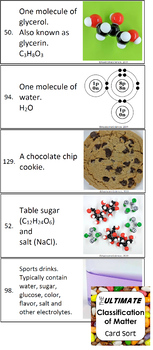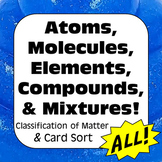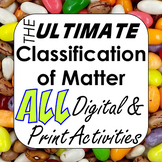Classification of Matter Ultimate Card Sort for Pure Substances & Mixtures
- PDF
Also included in
- Zoom down to the molecular level to visualize the different between elements, compounds, & mixtures, and organize your notes with handy flowchart style graphic organizers; two essential tools to equip yourself with when starting a journey into the classification of matter.Then, with this firm foPrice $22.05Original Price $24.50Save $2.45
- Are you ready to take on the ultimate challenge in classifying matter? It's time to put your classification agility and cunning to the test with these real-life PRO-level series of activities!Step up to the plate and prove that you're a master of elements, compounds, and mixtures as you navigate thPrice $80.10Original Price $89.00Save $8.90
Description
The original Classification of Matter Card Sort with 222-cards to sort! If your students do not yet understand how matter is classified, they certainly will after this hands-on activity! I am especially proud of this activity and wish I had it when I was learning to classify matter.
You have the flexibility to choose the depth to which your students classify matter:
- pure substances,
- mixtures,
- elements,
- compounds,
- homogeneous mixtures,
- heterogeneous mixtures,
- metals,
- non-metals,
- metalloids,
- inorganic compounds,
- organic compounds,
- solutions,
- colloids (foams, solid foams, liquid aerosols, emulsions, gels, solid aerosols, sols, solid sols),
- suspensions and
- mechanical mixtures.
Each card contains a description of the matter along with an image. Common names, chemical names, and chemical formulas are provided where appropriate. Images on cards include a mixture of photographs, Bohr-Rutherford, Lewis dot, Lewis structural, molecular models, etc. All images copyright AwesomeScience.
Each of the 24 decision tree placemats contains additional information to help guide students in the process of classifying matter.
This activity is flexible and adaptable enough to engage all levels of learners.
You have the option of selecting which cards use and when. You have the option of selecting how far down the classification tree your students go. Have students stop sorting at pure substances/mixtures and then resume sorting later. Have students sort only pure substances and save mixtures for a later date.
Teacher preparation:
- Print pages (best if printed in color on white cardstock)
- Cut out cards
- Distribute to students and – off they go!
***All printed material remains with the teacher.
Once you make your initial investment in printing, cutting, laminating, etc., you will have a resource that will last you a very long time.
Included in this package:
Page 1 - Copyright & Terms of Use
Page 2 - Educator instructions
Pages 3-4 - Student instructions
Page 5 - Student record sheet (optional)
Pages 6-21 - Classification of Matter Decision Tree Placemats (24 in total)
Pages 22-58 - Matter Cards (222 in total)
Pages 59-65 - Answers
The Complete Digital Adaptation of the Above Resource (Supplementary):
Additional Classification of Matter Activities may be found here:
- Elements Compounds & Mixtures Classification of Matter with Images & Note Organizers
- Classification of Matter Atoms Elements Molecules Compounds & Mixtures Bundle
⭐Click here to follow my store & receive the latest updates.
Original Artwork (©AwesomeScience). For Personal Use Only. Uneditable.
Page count does not include Terms of Use and links to supplementary activities.
Copyright ©AwesomeScience 2019 – The Present.
All Rights Reserved by Author.
By using this Resource you agree to the Terms as outlined in the Terms of Service. This Resource is for limited Personal Use only; not to be used, in part or in whole, for commercial purposes. Each Individual License is for use by one specific educator only. Additional licenses must be purchased for each additional educator. Except as permitted in Section 3 to deliver Resources electronically to Permitted Recipients, you may not post or otherwise make the Resource available on any website, application, shared drive or other sites or services.







